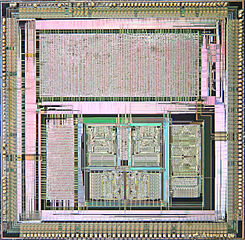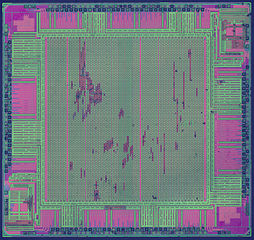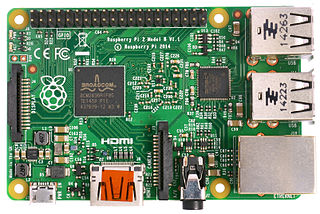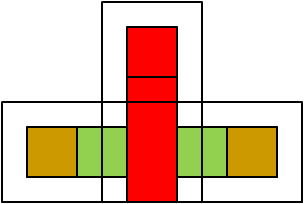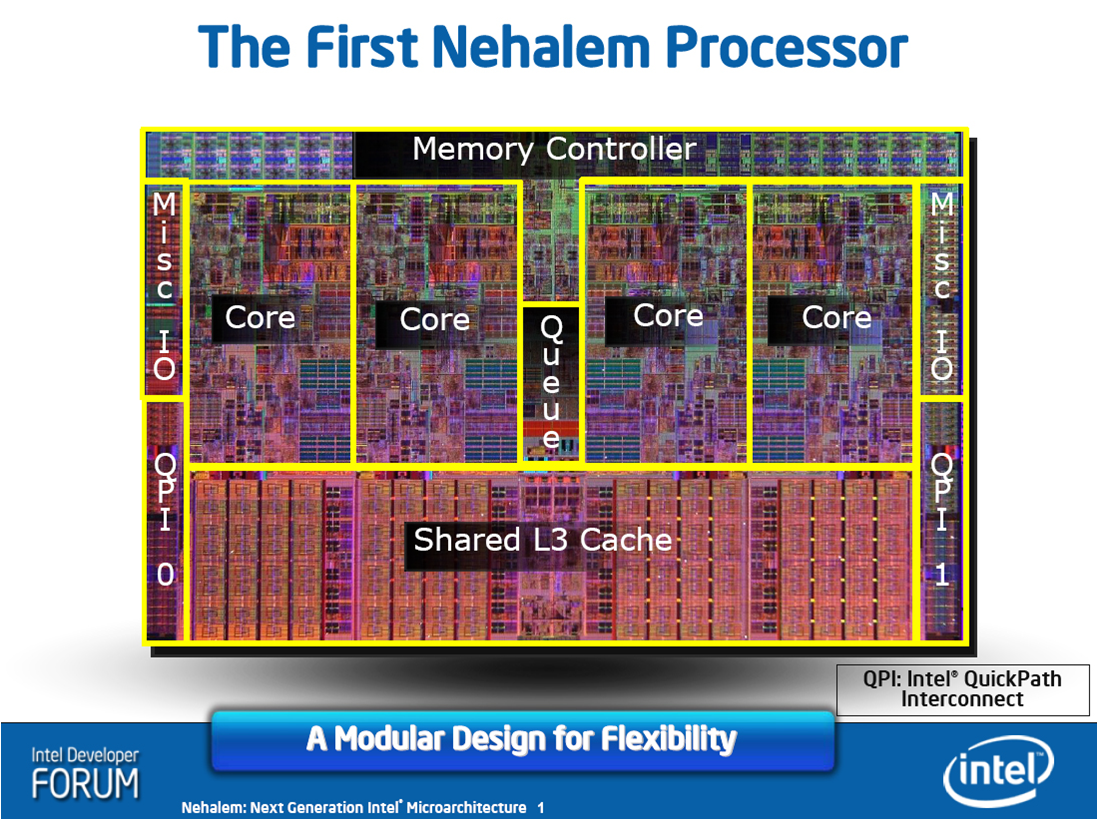Microelectronics03 MOSFETProf. Dr. Jörg Vollrath02 History |

|
Video of lecture 03 MOSFET, SPICE models, propagation delay 31.03.2021
|
Länge: 01:26:05 |
0:0:0 0 0:3:9 Goals today 0:6:36 Output and transfer curve 0:9:48 50 nm technology voltage limit 0:14:58 Subthreshold characteristic 0:16:49 Bulk source voltage and threshold voltage 0:19:25 Design by selecting W or number of unit transistors 0:24:29 MOSFET typical layout and rules 0:30:37 SPICE models 1 um, 50 nm 0:35:39 Infineon 130 nm MOSFET transistor parameters 0:40:29 SPICE models details 0:48:31 MOSFET as switch 0:50:39 Transistor RC model 0:52:39 Transistor Capacitances 0:59:19 Propagation delay 1:1:39 Rising and falling output 1:8:49 equivalent capacitance, Miller capacitance 1:16:49 Timing closure |
Overview
- Moores Law
- Microelectronic products, complexity, hierarchy
- Technologies: ASIC, FPGA, Microcontroller
- You have a basic understanding of a MOSFET
- Gate, Source, Drain, Bulk/Well: VGS, VDS, VBS
- Threshold voltage Vth, Drain source current IDS
- Transfer and output IV curve
- Output resistance RDSon
- Layout: Width, Length
- Capacitance and RDSon,C delay
Microelectronic products
 Computer |
 mobile phone | ||||
Consumer |
Automotive |
Industrial | |||
Hierarchical Description
| Top Down | System Subsystemi, Subsystemj Subsystemk, Subsysteml |
Bottom up |
Find one solution and then optimize
Citations
Optimization
“The First Rule of Program Optimization: Don't do it.
The Second Rule of Program Optimization (for experts only!): Don't do it yet.”
- Michael A. Jackson
Find a solution first
Diagnose problems
“We should forget about small efficiencies, say about 97% of the time:
premature optimization is the root of all evil.
Yet we should not pass up our opportunities in that critical 3%.
A good programmer will not be lulled into complacency by such reasoning,
he will be wise to look carefully at the critical code;
but only after that code has been identified”
- Donald Knuth
Identify the problem through test first
Design Flow
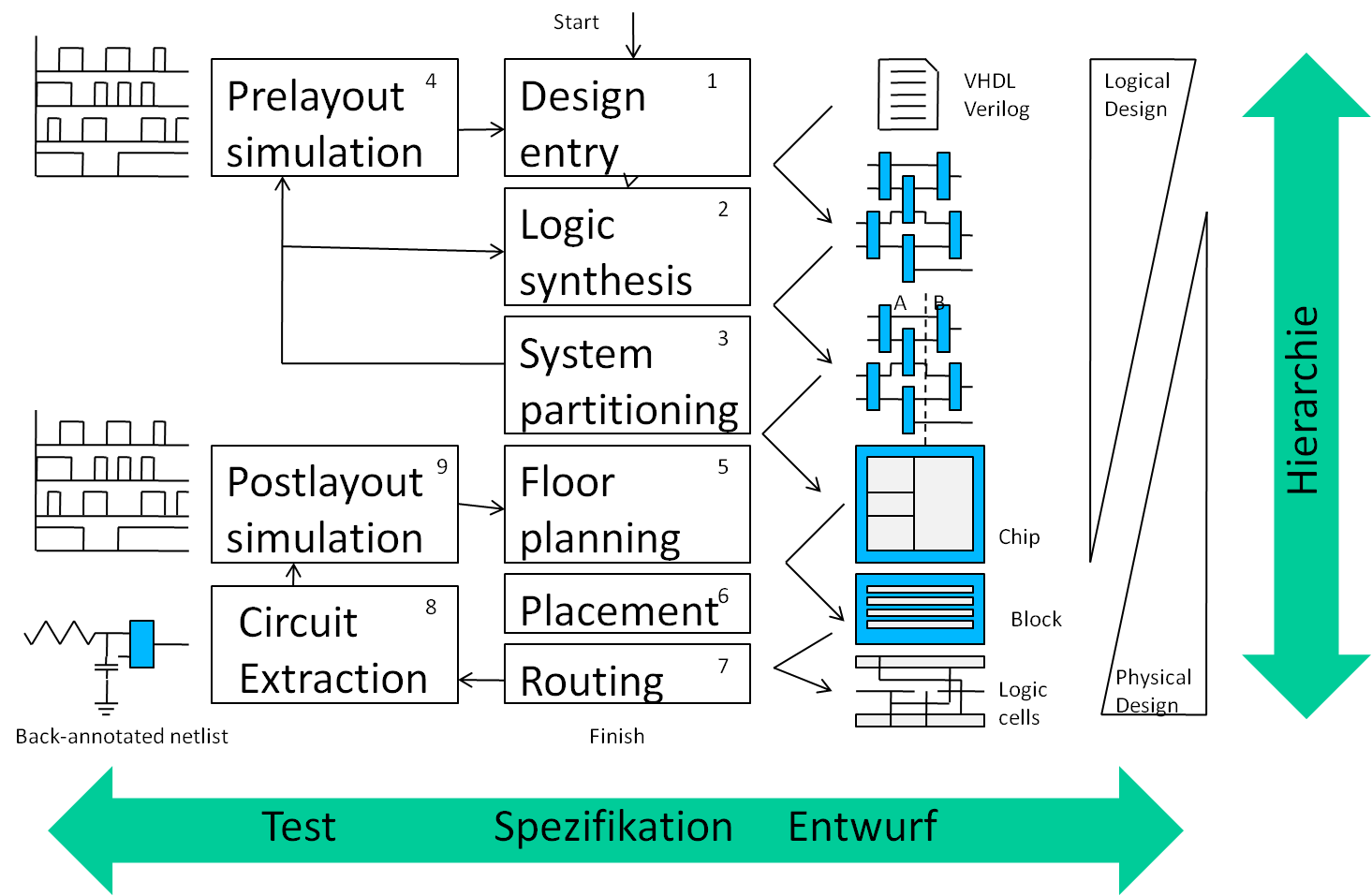
Technologies
ASIC: Application specific integrated circuit.
FPGA: File programmable gate array.
FPGA: File programmable gate array.
Systems (1)
Matlab, Labview can support some platforms.
Systems (2)
Zedboard: FPGA, µCField programmable gate array (FPGA)FPGA programming: VHDL, Verilog, IP Wizard Optional operating system: Linux Communication: Wifi, Webserver C(++), JavaScript Application: C(++), JavaScript |
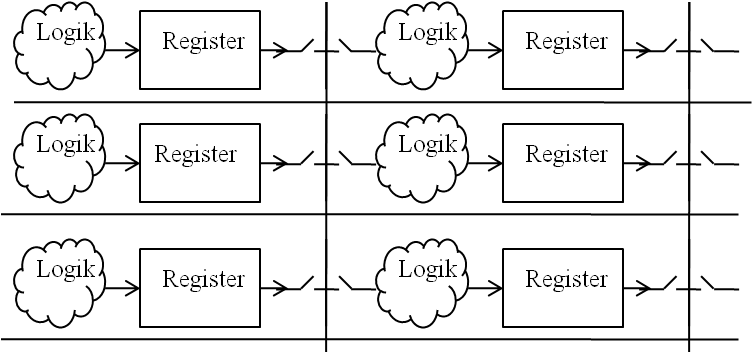 Switch matrix, logic and registers, programmable |
ASICProprietory software for design Electronic design automation (EDA) software tools: linux, perl, phyton, JavaScript |
Full custom ASIC Standard cell ASIC Gate Array Based Asic Foundries: TSMC, UMC Educational: MOSIS Europractice Zero To ASIC |
Matlab, Labview can support some platforms.
Microelectronics
Bottom up
MOSFET transistors, performance, layout and standard cells
NAND, AOI logic, scan flip flop
Place and route with VHDL
Make a chip with IOs, circuit and test structures
Electronic system

System Description
Modelling Simulation Structural Description Behavioral Description |
Analog and digital signals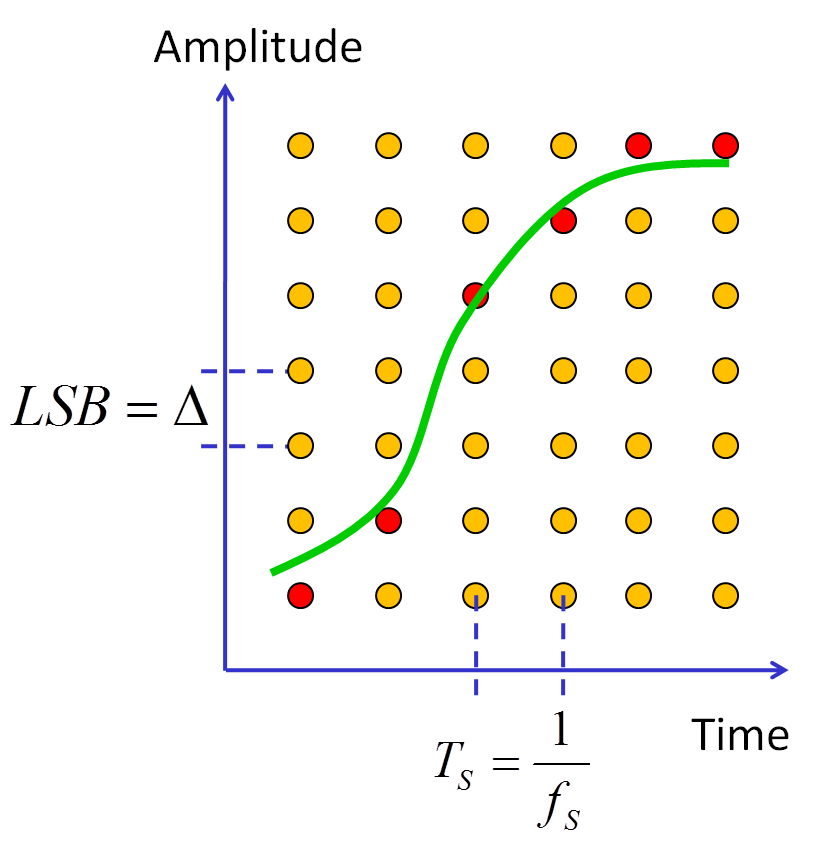
|
MOSFET Transistor
- Equations:
- Technology versus electrical properties
- Electrical properties for circuit simulation (SPICE program)
- 4 Terminal device
- Gate, source, drain, bulk (well)
- Voltage: VGS gate source voltage, VDS drain source voltage, VBS bulk source voltage
- Current: Gate, Drain source, bulk or substrate
- Electrical Characteristics
- Transfer Curve:
- lin IDS versus VGS -> shows threshold voltage
- log IDS versus VGS -> shows weak inversion and off current
- Output Curve: IDS versus VDS with various VGS -> shows output conductance
- Technology versus Electrical Characteristics: Roll of curve -> Vth versus Leff
Transistor Evolution
Summary Transistor Evolution
MOSFET- transistorMoore‘s law
Implications of reduced feature size:
30% Productivity gain per year
Power consumption, complexity/features, price
Hierarchical Design
Verification
Microelectronics deals with small electronic components
Transistor, diode, resistor, capacitor, inductance
Microelectronic systems are getting cheaper
Complex systems can be realized
Functions are getting cheaper
Typical microelectronic components of interest are:
Microcontroller (Microprocessor, memory, digital and analog functions)
FPGA (Field programmable gate arrays)
ASIC (Application specific integrated circuits)
This class shows how to design digital and analog CMOS microelectronic components and systems
Inverter schematic and layout
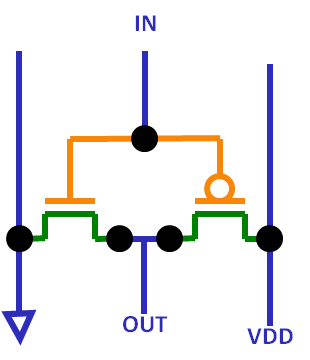
|
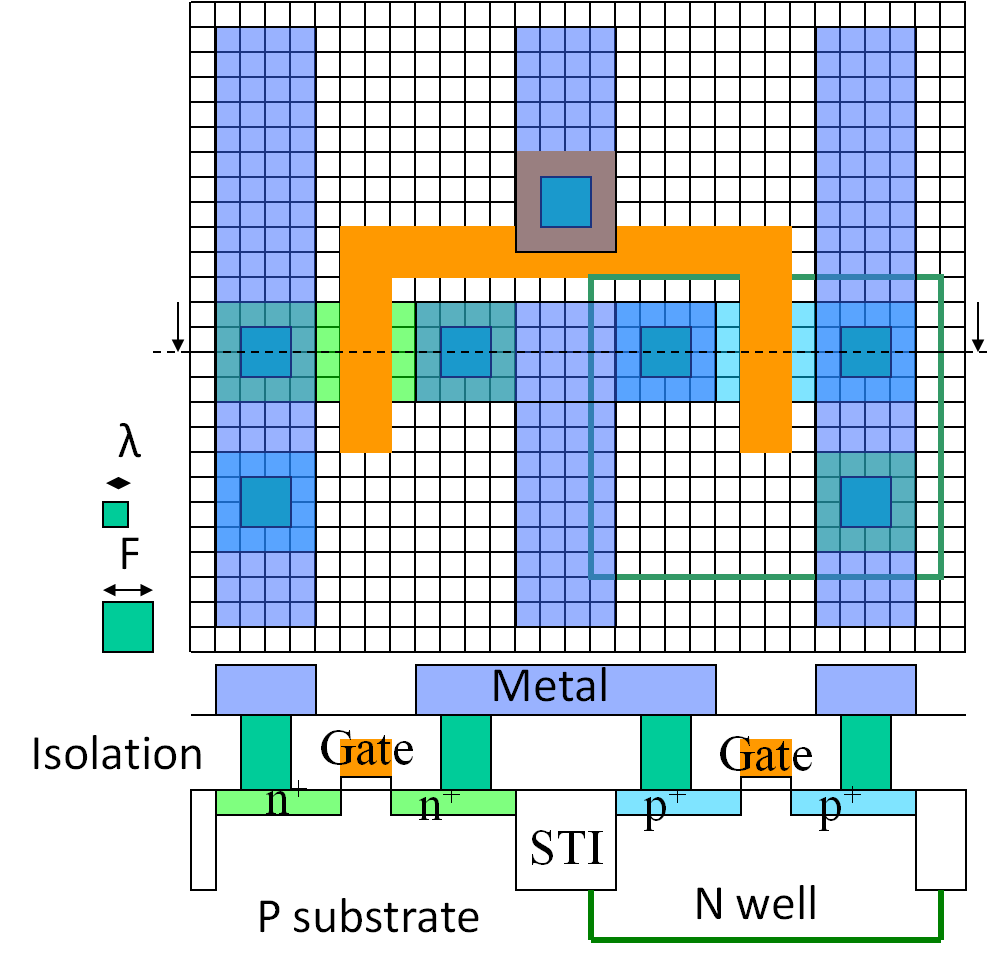
|
Schematic and layout are representing an inverter.
An inverter uses a NMOSFET and a PMOSFET.
The schematic shows the components and connections.
The layout has added different colors for different layers of the manufacturing process and each component.
These colors are transferred into the schematic showing the relationship between layout and schematic.
Wiring and transistor gates and diffusion have a minimum physical size of width and length of F.
There are also minimum distances required to prevent shorts.
It is difficult to automatically transform one view into the other.
A schematic is drawn to be able to easily understand the circuit. On the left is GND, on the right VDD, on the top inputs, on the bottom outputs.
In a schematic connection between 2 pins can be accomplished by labeling the pins with the same names. Lines can cross without resulting in short circuits.
A layout is drawn for symmetric and regular patterns, avoiding signal cross coupling and shape distortion, and having minimum size.
An inverter uses a NMOSFET and a PMOSFET.
The schematic shows the components and connections.
The layout has added different colors for different layers of the manufacturing process and each component.
These colors are transferred into the schematic showing the relationship between layout and schematic.
Wiring and transistor gates and diffusion have a minimum physical size of width and length of F.
There are also minimum distances required to prevent shorts.
It is difficult to automatically transform one view into the other.
A schematic is drawn to be able to easily understand the circuit. On the left is GND, on the right VDD, on the top inputs, on the bottom outputs.
In a schematic connection between 2 pins can be accomplished by labeling the pins with the same names. Lines can cross without resulting in short circuits.
A layout is drawn for symmetric and regular patterns, avoiding signal cross coupling and shape distortion, and having minimum size.
Equations of a n-channel MOSFET
|
\( I_{DS}= \cases{
\begin{matrix}
0 & \text{for} & V_{GS} \leq V_{th} & \text{Off}
\\
I_{on} exp^{\frac{ V_{GS}-V_{th} - \frac{kT}{e}}{\frac{kT}{e}}} \left( 1+\lambda V_{DS} \right)
& \text{for} & 0 \leq V_{GS} - V_{th} \lt \frac{kT}{e} & \text{Weak inversion}
\\
\beta \left( V_{GS}-V_{th} \right)^2 \left( 1+\lambda V_{DS} \right)
& \text{für} & \frac{kT}{e} \leq V_{GS} - V_{th} \lt V_{DS} & \text{Saturation}
\\
\beta \left( 2 \left( V_{GS}-V_{th} \right) V_{DS} - V_{DS}^2 \right)
& \text{for} & \frac{kT}{e} \leq V_{GS} - V_{th} \geq V_{DS} & \text{Linear}
\end{matrix}
}
\) \( \beta = \frac{\mu_n \epsilon_{ox}}{2d_{ox}} \frac{W}{L} = \frac{1}{2} \mu_n C_{ox}^{'} \frac{W}{L} = \frac{1}{2} K_{n}^{'} \frac{W}{L} = \frac{1}{2} K_{n} \) |
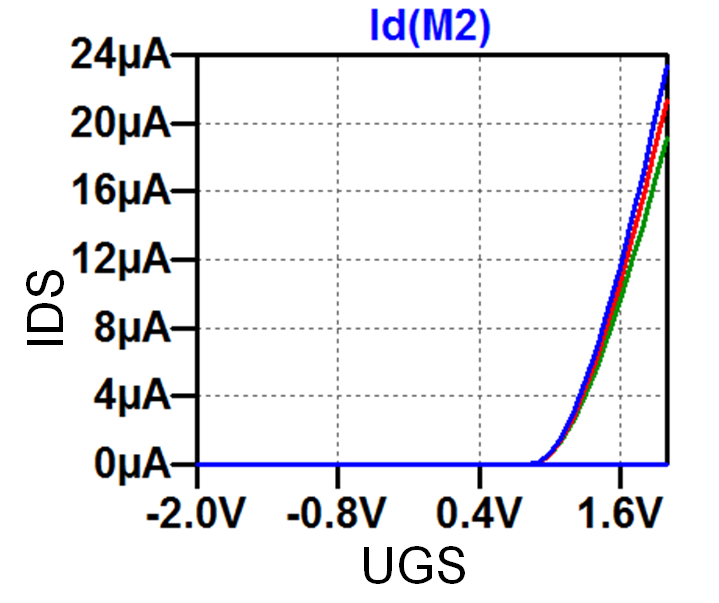 Quelle Vollrath
Quelle Vollrath |
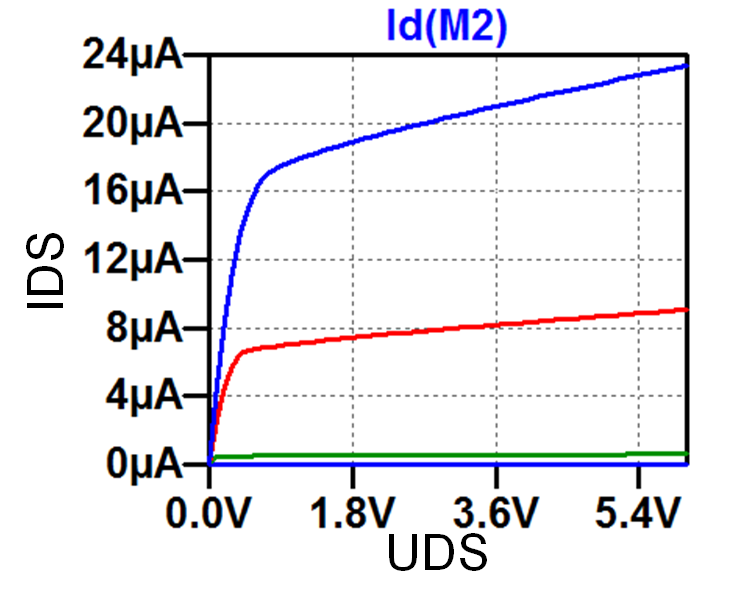 Quelle Vollrath
Quelle Vollrath |
Draw a IDS(VGS) and IDS(VDS) curve with Vth = 1V (0.3V), Kn = 100 µAV-2 and λ = 0.02 V-1
Vth threshold voltage
λ Output conductance
W width, L length
µ mobility
Cox = e /dox Gate oxide capacitance
Vt = kT/q (300K) = 0.0259 V
Simulation verifies first correct Vth and maximum current IDS at maximum voltage Vdd.
Then the input capacitance Cox is confirmed with AC simulation of a RC circuit having the MOSFET gate as capacitance C.
Microelectronic has only transistors as elements.
Design is done using transistors with choosing W and L.
MOS transistors are also used as capacitances, resistors, diodes and lateral bipolar transistors.
In sub 50nm processes FINFETs are used having a fixed L and W. These transistors are called unit transistors. Circuits are designed combining transistors in series or parallel to get the desired W/L ratio. This makes automated design easier.
Elektronik 3, 08 MOSFET
NFET Transistor subthreshold characteristic
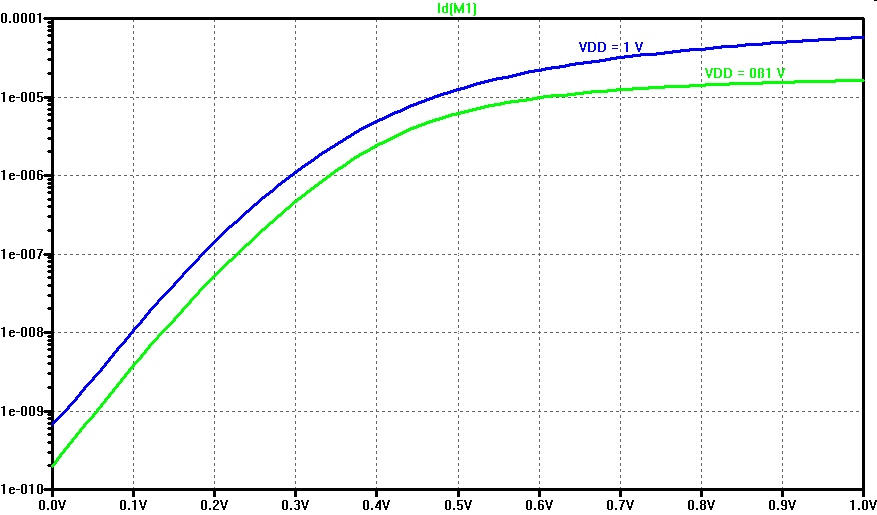
|
MOSFET transistors can also be operated in the subthreshold region for low voltage power supply.
The graph shows an increase in current by a factor of 10 for 100 mV change in VGS.
Threshold voltage Vth
| \( V_{th}= V_{th0} + \left( \gamma \sqrt{V_{SB}+2\phi_F}-\sqrt{2\phi_F}\right) \) |
|
MOSFET Transistor design
- Choosing W and L for IDS
- L is fixed to minimum feature size
- W can be changed
- Unit transistors have a fixed W and L
Circuits are using unit transistors in parallel and series - Threshold voltage Vth
- Vth is fixed for a given process
- Vth can change with:
oxide thickness, doping, length and width - Modern processes have different devices:
High Vth, low Vth, thick and thin oxide devices
Check in simulation different Vth and W L variations
MOSFET layout
|
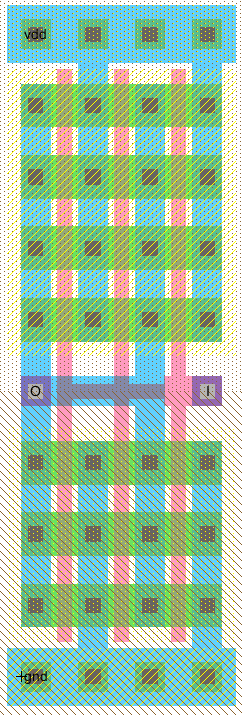
|
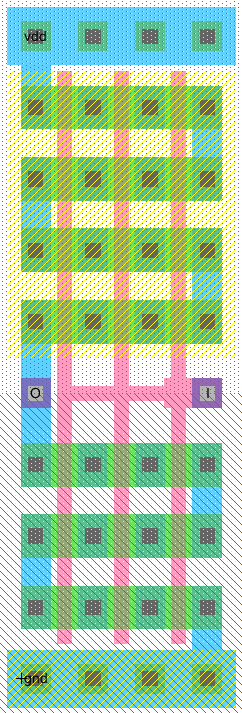
|
sclib.jelib: UNITExample{lay}, UNITLong{lay}
MOSFET SPICE models
| Long channel MOSFET F = 1 µm, VDD = 5 V | |||
| Parameter | NMOS | PMOS | Comment |
| VTh | 0.8 V | 0.9 V | Typical |
| KP | 120 µA/V2 | 40 µA/V2 | dox = 20 nm |
| C'ox | 1.75 fF/µm2 | 1.75 fF/µm2 | Cox = C'ox W L |
| λ | 0.01 V-1 | 0.0125 V-1 | L = 2 |
| R | 15 kΩ L/W | 45 kΩ L/W | |
| Short channel MOSFET F = 50 nm, VDD = 1 V | |||
| Parameter | NMOS | PMOS | Comment |
| VTh | 0.28 V | 0.28 V | Typical |
| KP | 60 µA/V2 | 30 µA/V2 | dox = 1.4 nm |
| C'ox | 25 fF/µm2 | 25 fF/µm2 | Cox = C'ox WL |
| λ | 0.6 V-1 | 0.3 V-1 | L = 2 |
| R | 34 kΩ/W | 68 kΩ/W | |
Propagation delay can be calculated with tPD = 0.7 · R · C
R is the resistance of NFET or PFET. C is the sum of the output capacitance (Coxn) and input capacitance (3/2 Cox).
C = (3/2 + 1 ) (Coxn + Coxp)
A 1 µm unit transistor has a Cox of 1.75 fF/µm2 and R of 15 kΩ (45 kΩ).
tPD = 0.7 · 2 · 1.75 fF · 0.5 · ( 15 kΩ + 45 kΩ) = 73.5 ps
A 50 nm unit transistor has a Cox of 25 fF/µm2 · 50nm · 50 nm = 62.5 aF and R of 34 kΩ (68 kΩ).
tPD = 0.7 · 2 · 25 fF/µm2 · 50 nm · 50 nm · 0.5 · ( 34 kΩ + 68 kΩ) = 2.23 ps
Simulated inverter 24..32 ps
More models:
Baker: 1 µm MOSFET model, 50 nm MOSFET model, cmosedu_models.txt
Sedra Smith Level=1 5 µm, 0.5 µm: sedra_lib.lib
Allen, Holberg Level=3 0.8 µm: Holberg.txt
TSMC 0.25um CMOS MOSFETs (level 3) t14y_tsmc_025_level3.lib from MOSIS .
TSMC 0.18um CMOS MOSFETs (level 3) t92y_mm_non_epi_thk_mtl-params_TSMC_018.txt from MOSIS .
180nm CMOS Model
130nm CMOS Model
Archived PTM CMOS models 7nm, 10nm, 14nm, 16nm, 20nm, 22nm, 32nm, 45nm, 65nm, 90nm, 130nm, 180nm
.model CD4007P PMOS(LEVEL=1 KP=500u VT0=-1 LAMBDA=0.002 CGSO=45n CGBO=2n CGDO=45n)
.model ALD1107P PMOS(LEVEL=1 KP=0.2m VT0=-0.7 LAMBDA=0.018 CGDO=100n CGSO=100n)
R is the resistance of NFET or PFET. C is the sum of the output capacitance (Coxn) and input capacitance (3/2 Cox).
C = (3/2 + 1 ) (Coxn + Coxp)
A 1 µm unit transistor has a Cox of 1.75 fF/µm2 and R of 15 kΩ (45 kΩ).
tPD = 0.7 · 2 · 1.75 fF · 0.5 · ( 15 kΩ + 45 kΩ) = 73.5 ps
A 50 nm unit transistor has a Cox of 25 fF/µm2 · 50nm · 50 nm = 62.5 aF and R of 34 kΩ (68 kΩ).
tPD = 0.7 · 2 · 25 fF/µm2 · 50 nm · 50 nm · 0.5 · ( 34 kΩ + 68 kΩ) = 2.23 ps
Simulated inverter 24..32 ps
More models:
Baker: 1 µm MOSFET model, 50 nm MOSFET model, cmosedu_models.txt
Sedra Smith Level=1 5 µm, 0.5 µm: sedra_lib.lib
Allen, Holberg Level=3 0.8 µm: Holberg.txt
TSMC 0.25um CMOS MOSFETs (level 3) t14y_tsmc_025_level3.lib from MOSIS .
TSMC 0.18um CMOS MOSFETs (level 3) t92y_mm_non_epi_thk_mtl-params_TSMC_018.txt from MOSIS .
180nm CMOS Model
130nm CMOS Model
Archived PTM CMOS models 7nm, 10nm, 14nm, 16nm, 20nm, 22nm, 32nm, 45nm, 65nm, 90nm, 130nm, 180nm
CD4007
.model CD4007N NMOS(LEVEL=1 KP=500u VT0=1 LAMBDA=0.002 CGSO=45n CGBO=2n CGDO=45n).model CD4007P PMOS(LEVEL=1 KP=500u VT0=-1 LAMBDA=0.002 CGSO=45n CGBO=2n CGDO=45n)
ALD1106, ALD1107
.model ALD1106N NMOS(LEVEL=1 KP=0.48m VT0=0.7 LAMBDA=0.018 CGDO=100n CGSO=100n).model ALD1107P PMOS(LEVEL=1 KP=0.2m VT0=-0.7 LAMBDA=0.018 CGDO=100n CGSO=100n)
130 nm Infineon MOSFET transistors

Infineon 130 nm platform
